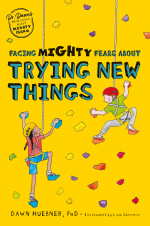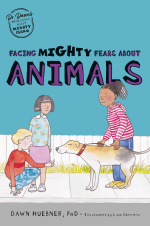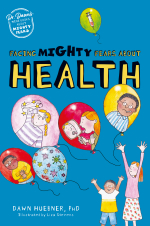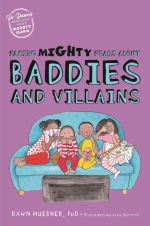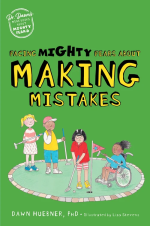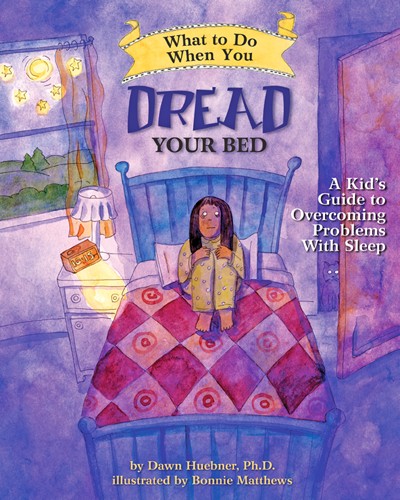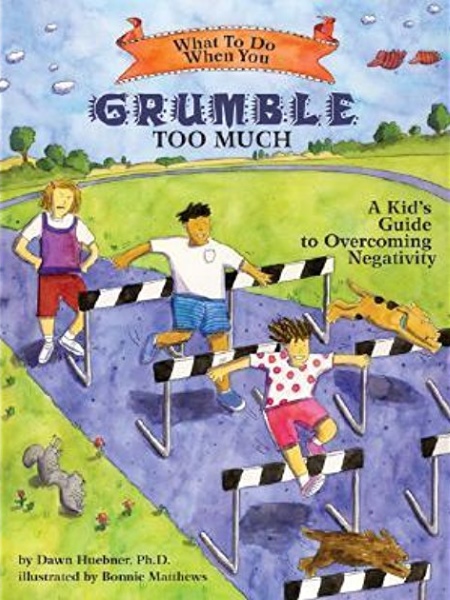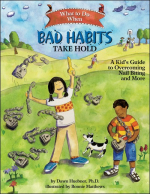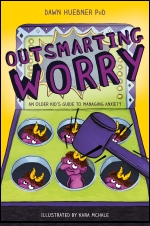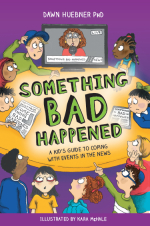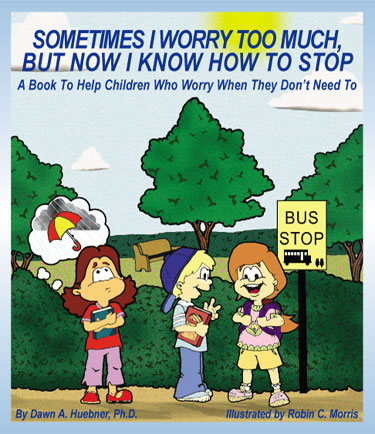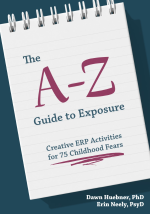Dawn Huebner, PhD, is the author of an ever expanding list of books teaching cognitive-behavioral strategies that empower children to break free from the problems holding them hostage.
Lively, encouraging, and easy to follow, each book motivates children to think and act in new ways. Described as “must have” resources for parents, teachers, and therapists – with well over 1 million copies in 23 languages – Dr. Huebner’s books help kids live happier lives.
Book List
Available wherever books are sold or click the Purchase button to buy directly from my publishers.
Dr. Dawn’s Mini Books About Mighty Fears series
Facing Mighty Fears About Being Apart From Parents

Many children worry about doing things on their own, with fears escalating to the point of not being able to leave their parents’ side. But staying with a parent isn’t always possible, and doing things independently is an important part of growing up.
Facing Mighty Fears About Being Apart From Parents teaches 3 steps to manage oversize fears. Fun Facts about separation in the animal kingdom keep children engaged, while a Note to Parents and Caregivers and Supplemental Resource section make this the perfect guide for parents and mental health professionals. Read more.
Facing Mighty Fears About Throwing Up
No one likes throwing up. No one likes to see it, smell it, or experience it. But emetophobia is different, turning disgust into dread, getting in the way of day-to-day life.
Facing Mighty Fears About Throwing Up teaches specific techniques to help shrink this surprisingly common phobia, helping children accept that puke happens, and life goes on. A Note to Parents and Caregivers, along with a supplemental Resource Page, make this the perfect guide for families and mental health counselors. Read more.
Facing Mighty Fears About Trying New Things
First time jitters are normal, but when they turn into tears and outright refusal to go new places or try new things, the world shrinks in problematic ways.
Facing Mighty Fears About Trying New Things teaches children to manage uncertainty about new experiences. Fun Facts, First Time Acts, and illustrations featuring diverse children engage readers while encouraging a gradual increase in bravery. A Note to Parents and caregivers, along with a supplemental Resource Page, make this the perfect guide for families and mental health counselors. Read more.
Facing Mighty Fears About Animals
Fear of animals that slither, bite and sting is common among children. But sometimes healthy caution turns to outright fear, getting in the way of going places and doing things.
Facing Mighty Fears About Animals teaches children techniques to shrink over-size fears. Written with warmth and humor, and chock full of Fun Facts about bees, dogs, spiders and snakes, this book is a game-changer. A Note to Parents and Caregivers, along with a supplemental Resource Page, make this the perfect guide for families and mental health counselors. Read more.
Facing Mighty Fears About Health
Thinking about our bodies’ functions can be scary, especially for children. Sometimes this awareness grows into Health Anxiety, an intense, unshakeable fear accompanied by hypervigilance about breathing, swallowing, aches, and pains.
Facing Mighty Fears About Health teaches children to manage scary thoughts more effectively. Fun Facts about the body engage children as they practice the 3 steps sure to ease false-alarm fears. A Note to Parents and Caregivers, along with a supplemental Resource Page, make this the perfect guide for families and mental health counselors. Read more.
Facing Mighty Fears About Baddies and Villains
Many children are afraid of baddies and villains. But sometimes fear far outstrips danger, and children begin living in restricted ways.
Facing Mighty Fears About Baddies and Villains teaches techniques to help children shrink their oversize fears. Written with warmth and humor, and chock full of Fun Facts, this book is a game-changer. A Note to Parents and Caregivers, along with a supplemental Resource Section, make this the perfect guide for families and mental health professionals.
This book is part of the Dr. Dawn’s Mini Books About Mighty Fears series, designed to help children ages 6-10 tackle their fears and live happier lives. Read more.
Facing Mighty Fears About Making Mistakes
Many children avoid taking on challenges, melting down when the going gets tough. But doing things you aren’t very good it as one of the best ways to keep your brain healthy and strong. That means it’s okay to mess up, and fumble, and fail. In fact, you should do these things. Mistakes are exactly what your brain needs to grow.
Facing Mighty Fears About Making Mistakes helps 6-10-year-olds get more comfortable with imperfection. Fun Facts about famous mistakes engage children, while a Note to Parents and Caregivers and supplemental Resource Section make this the perfect guide for parents and mental health professionals. Read more.
What To Do Guides For Kids series
What to Do When You Worry Too Much: A Kid’s Guide to Overcoming Anxiety

 Did you know that worries are like tomatoes? No, you can’t eat them, but you can make them grow, simply by paying attention to them. If your worries have grown so big that they bother you almost every day, this book is for you.
Did you know that worries are like tomatoes? No, you can’t eat them, but you can make them grow, simply by paying attention to them. If your worries have grown so big that they bother you almost every day, this book is for you.
What to Do When You Worry Too Much, 2nd edition, is an interactive self-help book designed to guide 6 – 12 year olds and their parents through the cognitive-behavioral techniques most often used in the treatment of generalized anxiety. Metaphors and humorous illustrations make difficult concepts easy to understand, while prompts to draw and write help children to master new skills related to reducing anxiety. Read more.
What To Do When Your Brain Gets Stuck: A Kid’s Guide to Overcoming OCD
Did you know that people have brain sorters that keep their brains from getting cluttered with unnecessary thoughts? Sometimes these brain sorters get mixed up, though, holding onto thoughts that frighten kids. If this has happened to you, if it’s hard for you to feel safe or sure of yourself because scary thoughts have gotten stuck, this book is for you.
What To Do When Your Brain Gets Stuck guides children and their parents through the cognitive-behavioral techniques used to treat Obsessive Compulsive Disorder. This interactive self-help book turns kids into super-sleuths, able to recognize and more appropriately respond to OCD’s tricks. Read more.
What To Do When Your Temper Flares: A Kid’s Guide to Overcoming Problems with Anger

 Did you know that anger is like fire? It starts with a spark, igniting us with energy and purpose. But it can also blaze out of control, causing lots of problems. If you’re a kid whose temper quickly flares, a kid whose anger gets too big, too hot, too fast, this book is for you.
Did you know that anger is like fire? It starts with a spark, igniting us with energy and purpose. But it can also blaze out of control, causing lots of problems. If you’re a kid whose temper quickly flares, a kid whose anger gets too big, too hot, too fast, this book is for you.
What to Do When Your Temper Flares, 2nd edition, guides children and their parents through the cognitive-behavioral techniques used to treat problems with anger. Engaging examples, lively illustrations, and step-by-step instructions teach children a set of “anger dousing” methods aimed at cooling angry thoughts and controlling angry actions, resulting in calmer, more effective kids. Read more.
What To Do When You Dread Your Bed: A Kid’s Guide to Overcoming Problems with Sleep
Wouldn’t it be great if you could climb into bed, snuggle under your covers, and fall asleep without any fuss or fear? Without listening for noises or thinking about bad guys? Without an extra drink, or an extra hug, or an extra trip to the bathroom? Bedtime is tough for many kids. If you’re a kid who dreads your bed, and are convinced that nothing short of magic will make nighttime easier, this book is for you.
What To Do When You Dread Your Bed is the complete resource for educating, motivating, and empowering children to fall asleep and stay asleep – like magic! Read more.
What To Do When You Grumble Too Much: A Kid’s Guide to Overcoming Negativity
Did you know that life is like an obstacle course? It’s exciting and fun, but full of tricky spots to get through. If you’re a kid who feels so frustrated by those tricky spots that it’s hard to enjoy the good things in life, this book is for you.
What to Do When You Grumble Too Much guides children and their parents through the cognitive behavioral techniques used to treat negative thinking. Lively metaphors and illustrations make difficult concepts easy to understand, allowing children to see life’s hurdles in a new way. Read more.
What To Do When Bad Habits Take Hold: A Kid’s Guide to Overcoming Nail Biting and More
Nail biting. Thumb sucking. Hair twirling. Scab picking. Shirt chewing. Do you have a habit that’s hard to stop? A habit that embarrasses you or gets you in trouble? If so, you’re not alone. Lots of kids have habits they wish they could lose. But habits are stronger than wishes. They lock on, holding you tight. Even if you want to break free, you can’t. Unless you have the keys.
What to Do When Bad Habits Take Hold guides children and their parents through the cognitive-behavioral techniques used to treat a variety of habits. Read more
More Books for Kids
Outsmarting Worry: An Older Kid’s Guide to Managing Anxiety
Worry has a way of growing, shifting from not-a-big-deal to a VERY BIG DEAL in the blink of an eye. This big-deal Worry is tricky, luring children into behaviors that keep the anxiety cycle going. Children often find it hard to fight back against Worry, but not anymore.
Outsmarting Worry teaches 9 to 13-year-olds and the adults who care about them a specific set of skills that makes it easier to face – and overcome – worries and fears. Read more.
The Sibling Survival Guide: Surefire Ways to Solve Conflicts, Reduce Rivalry, and Have More Fun With Brothers and Sisters
Having a brother or sister can be tough. It can also be great, but it’s hard to see the great parts with so many bad parts getting in the way. Problems like fighting and bossing. Teasing and jealousy. Tattling. Pestering. And more. But what if you could do something about those problems? Clear them away. Then you’d be able to actually enjoy your siblings!
The Sibling Survival Guide speaks directly to children ages 9-12, teaching skills to help them manage feelings and resolve conflicts, strengthening the bonds between brothers and sisters. Read more or view the trailer.
Something Bad Happened: A Kid’s Guide to Learning About Events in the News
When children learn about something BIG and BAD – even when they hear only bits and pieces – their brains get busy trying to make sense of it. This indispensable book guides 6 to 12-year-olds and the adults who care about them through tough conversations about serious world events. Where did it happen? Why did it happen? Will it happen again?
Something Bad Happened guides children ages 6 to 12 and the adults who care about them through tough conversations about serious world events, from environmental threats to human tragedies. Read more.
Sometimes I Worry Too Much, But Now I Know How to Stop
This is the story of Anna, a child whose worries get the best of her. Anna is frustrated when adults tell her to just stop worrying, a task that seems impossible to her. Anna meets a psychologist who teaches her cognitive-behavioral techniques to use when worries arise. These techniques are presented in enough detail to allow children reading the book to learn, as Anna learns, how to control worries. Read more.
Books for Therapists
The A-Z Guide to Exposure: Creative ERP Activities for 75 Childhood Fears
The art of exposure lies in perfectly pitched challenges. Get them wrong and nothing changes. Get them right and you set an anxious child free.
The A-Z Guide to Exposure contains 75 creative, user-friendly lists of exposure activities appropriate for 5-12-year-olds struggling with anxiety. Entries cover a wide range of fears and concerns such as clowns, intrusive thoughts, mistakes, picky eating, and vomiting.
An essential addition to the therapeutic toolbox of practitioners using Exposure and Response Prevention (ERP), this unique resource combines evidence-based guidance with inventive, engaging, actionable activities for an extensive list of childhood fears. Read more..


